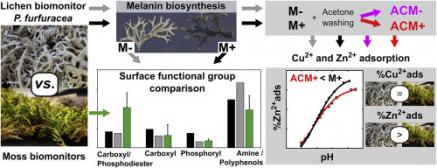- Home
- Department
- Research
- Teaching
- Post Graduate Studies
- Services and Equipment
- Knowledge Transfer
New publication - " Influence of secondary metabolites on surface chemistry and metal adsorption of a devitalized lichen biomonitor"
Published on Environmental Pollution by the research group of prof. Mauro Tretiach
News typology:
home
Abstract
Despite the broad use of lichens as biomonitors of airborne trace elements, the surface chemistry and metal adsorption parameters of these organisms are still poorly known. The current investigation is aimed at (i) quantifying the acid-base surface properties and the first-order physical-chemical parameters of Cu2+ and Zn2+ adsorption of devitalized Pseudevernia furfuracea, a lichen commonly used in biomonitoring of airborne trace elements, and (ii) comparing the results with those available for moss biomonitors. Equilibrium constants and metal-binding site concentrations were calculated with a thermodynamic model by taking into account the presence/absence of ancillary extracellular cell wall compounds, namely melanin and acetone-soluble lichen substances. An acid–base titration experiment performed in the pH range of 3–10 showed that melanised and non-melanised P. furfuracea samples have lower pHPZC (3.53–3.99) and higher metal-binding site concentrations (0.96–1.20 mmol g−1) compared to that of the mosses investigated so far at the same experimental conditions. Melanin biosynthesis increased the content of carboxyl and phosphoryl groups and reduces that of amine/polyphenols. Cu2+ and Zn2+ adsorption was unaffected by the degree of melanisation while the removal of extracellular lichen substances slightly decreased Zn2+ adsorption. Although Cu2+ and Zn2+ adsorption parameters related to P. furfuracea surfaces were 3 times lower than in the mosses, lichen samples adsorbed the same amount of Cu2+ and 30% more Zn2+. The present study contributes in understanding the role of ancillary cell wall compounds in Cu2+ and Zn2+ adsorption in a model lichen. It also provides a first comparison between the surface physico-chemical characteristics of lichens and mosses frequently used as biomonitors of trace elements.
Abstract grafico

Last update: 01-27-2021 - 15:56



